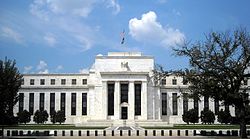
On September 17, 2019, interest rates on overnight repurchase agreements (or "repos"), which are short-term loans between financial institutions, experienced a sudden and unexpected spike. A measure of the interest rate on overnight repos in the United States, the Secured Overnight Financing Rate (SOFR), increased from 2.43 percent on September 16 to 5.25 percent on September 17. During the trading day, interest rates reached as high as 10 percent. The activity also affected the interest rates on unsecured loans between financial institutions, and the Effective Federal Funds Rate (EFFR), which serves as a measure for such interest rates, moved above its target range determined by the Federal Reserve.
Contents
- Background
- Overnight lending
- The repo market
- The federal funds market
- Events
- Rates increase
- Response by the Federal Reserve
- Aftermath
- Suggested causes
- Temporary cash shortage
- Other causes
- See also
- Notes and references
- Notes
- References
- Sources
- External links
This activity prompted an emergency intervention by the Federal Reserve Bank of New York, which injected $75 billion in liquidity into the repo markets on September 17 and continued to do so every morning for the rest of the week. On September 19, the Federal Reserve's Federal Open Market Committee also lowered the interest paid on bank reserves. These actions were ultimately successful in calming the markets and, by September 20, rates had returned to a stable level. The Federal Reserve Bank of New York continued to regularly provide liquidity to the repo market until June 2020.
The causes of the rate spike were not immediately clear. Economists later identified its main cause to be a temporary shortage of cash available in the financial system, which was itself caused by two events taking place on September 16: the deadline for the payment of quarterly corporate taxes and the issuing of new Treasury securities. The effects of this temporary shortage were exacerbated by declining level of reserves in the banking system. Other contributing factors have been suggested by economists and observers.




